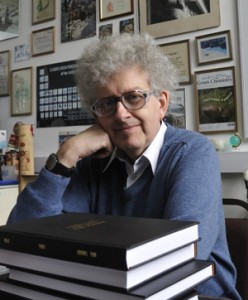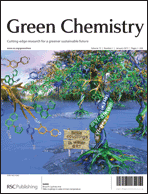The search for alternatives to volatile organic solvents is one of the continuing major themes in Green Chemistry. “Solvents” are explicitly mentioned in principle 5 of the 12 Green Chemistry Principles, but their use impacts of course also directly on issues such as waste prevention, energy efficiency, and safety. The search for alternative materials and concepts to facilitate solution phase processes towards the goals of sustainability forms a natural link between Green Chemistry and Engineering. Since the year 2000, the biennial conference “Green Solvents” brings together researchers from academia and industry, as well as students, to discuss the progress in science and application in this area. As in previous years, the presenters at the 2012 edition of the conference have been invited to contribute a review or original research paper to the journal and you will find the resulting articles bundled in this issue.
The organization of six editions of this meeting together with Peter Wasserscheid and Ken Seddon has been scientifically most rewarding and personally a real pleasure. The concept to organize the program without parallel sessions, arranging it according to the scientific and technical challenges rather than the materials or methods has led to most fruitful interactions and stimulating discussions. One of the most striking developments reflected across the board is that the advanced fluids such as ionic liquids, supercritical fluids, water, or liquid polymers are often not adequately described as “solvents” when used for molecular transformations or separation techniques. They act as additives, stabilizers, matrices, switchable components, catalysts, etc. Unlike with traditional solvents, only very small amounts of the fluids are often required, for example to combine reactivity and separation in catalyst immobilization. Smart systems change their properties upon external stimuli or directly interact with reactive components to steer a reaction. Reaction engineering concepts for flow chemistry open new approaches with these materials and vice versa. So, are we at the stage “Mission Completed”?
Actually – I don’t really think so: striving for sustainability is an iterative process and if we are doing well, we can always do better! Immobilizing a catalyst today, we are already satisfied if it retains largely its activity and selectivity from solution; very often, we find that the supporting matrix interacts with the catalyst leading to a reduced performance. There is no reason why the interaction should not lead to an activation or increase in selectivity! In fact, there are a – still slowly – increasing number of observations that support this idea. Is it possible to switch not only between solubility properties, but also between reactivities? How can heat exchange be controlled in reactive systems without using solvents? Can we use fluids that stabilize nanoparticles for the control of their reactivity just as we use ligands to control single site catalysts? If we find such seemingly elegant solutions, will they really improve the sustainability of industrial process chains upon implementation? We are far from giving satisfactory answers to these and many more very fundamental questions!
Solution phase synthesis is dominating the fine chemicals and pharmaceuticals industry, and resource and energy efficient production is increasingly making a difference in the business models of these sectors. Material synthesis and processing is also highly depending on the liquid phase. Utilization of biomass requires solution phase processes even in the very early stages of the supply chain, in large scale bio-refineries just as well as for decentralized operations. Chemical transformations lie also at the intersection of the energetic and chemical supply chain. In all these crucial areas of application, novel concepts and materials for solution phase processes can make a difference!
Therefore, I am already today looking forward to the next edition of the “Green Solvents” conference: it will be held in Dresden, Germany, from October 19–22 2014 (for details, see: http://www.dechema.de/gsfs2014). If you enjoy reading the articles in this issue, if you share the enthusiasm for the exciting scientific challenges in this area, or if you see potential connections to your own research, you don’t want to miss this event!

Professor Walter Leitner – Chair of the Green Chemistry Editorial Board


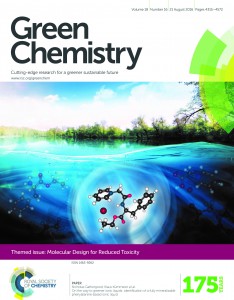









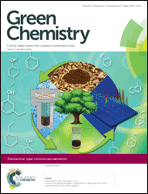
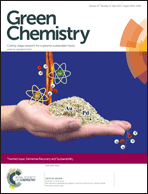
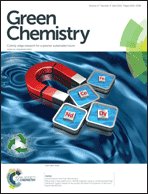
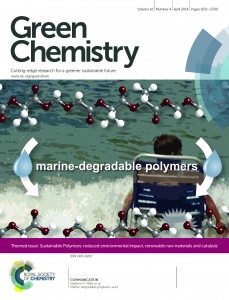
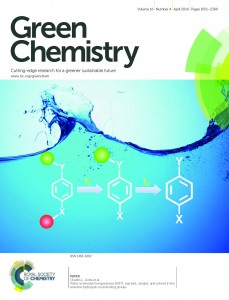
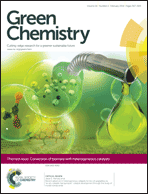 The front cover this month (pictured left) features a review by Jesse Hensley and co-workers from Golden, Colorado. In their article they focus on recent model compound studies of catalysts for hydrodeoxygenation of biomass pyrolysis products, with an emphasis on mechanisms, reaction networks, and structure–function relationships.
The front cover this month (pictured left) features a review by Jesse Hensley and co-workers from Golden, Colorado. In their article they focus on recent model compound studies of catalysts for hydrodeoxygenation of biomass pyrolysis products, with an emphasis on mechanisms, reaction networks, and structure–function relationships.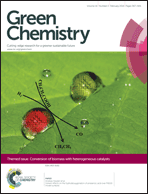 The inside front cover this month (pictured right) features work by Andreas Heyden and co-workers from Columbia, South Carolina. In their work they report a theoretical study of the effects of various solvents on the mechanism of the hydrodeoxygenation of propanoic acid over Pd(111).
The inside front cover this month (pictured right) features work by Andreas Heyden and co-workers from Columbia, South Carolina. In their work they report a theoretical study of the effects of various solvents on the mechanism of the hydrodeoxygenation of propanoic acid over Pd(111).



